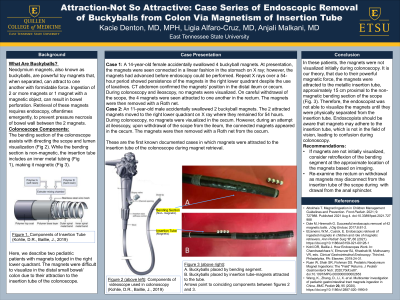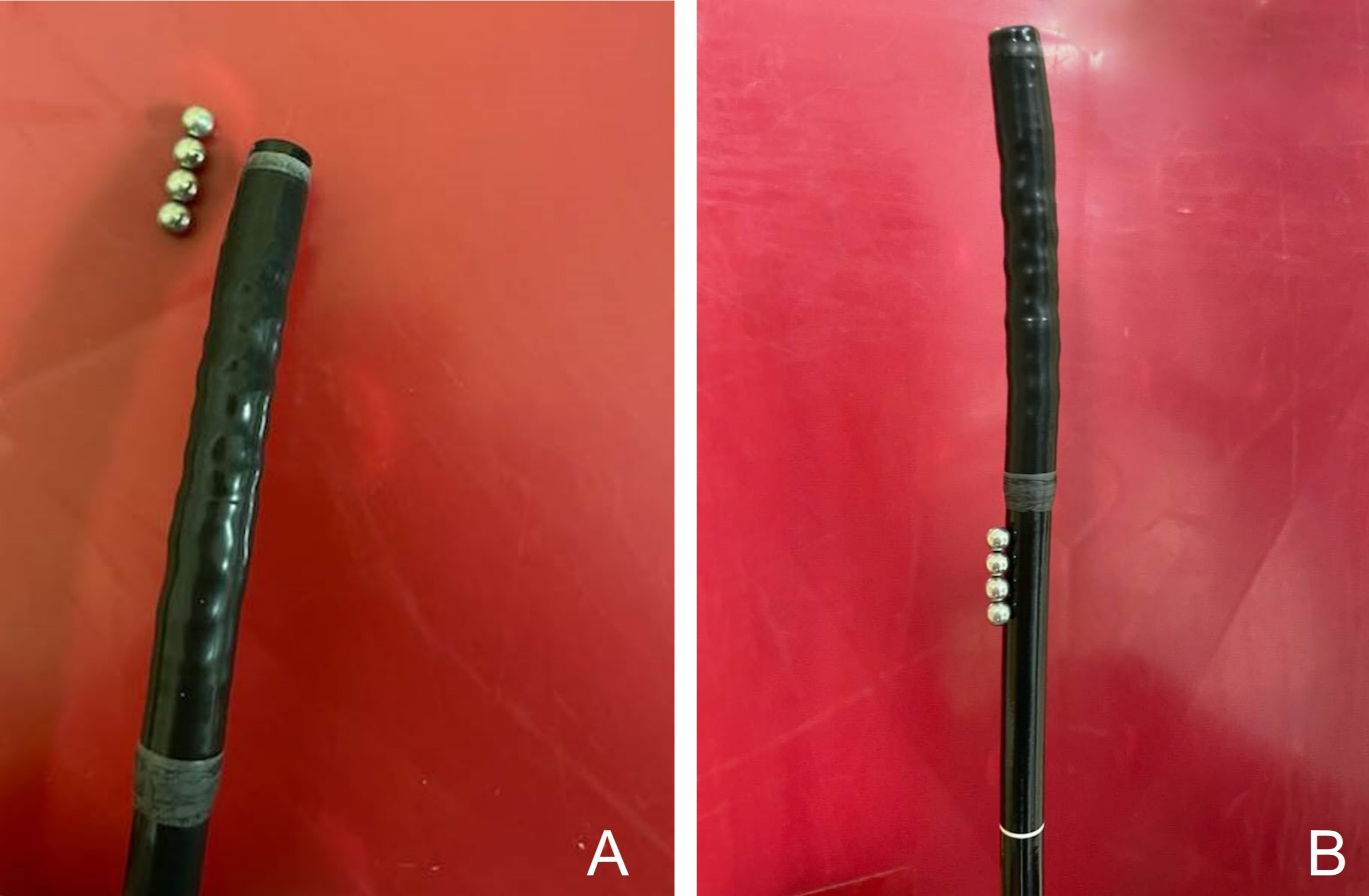Back


Poster Session A - Sunday Afternoon
Category: Pediatrics
A0612 - Attraction-Not so Attractive: Case Series of Endoscopic Removal of Buckyballs from Colon via Magnetism of Insertion Tube
Sunday, October 23, 2022
5:00 PM – 7:00 PM ET
Location: Crown Ballroom

Has Audio

Kacie H. Denton, MD, MPH
East Tennessee State University
Johnson City, TN
Presenting Author(s)
Kacie H. Denton, MD, MPH, Ligia Alfaro Cruz, MD, Anjali Malkani, MD
East Tennessee State University, Johnson City, TN
Introduction: Neodymium magnets, also known as buckyballs, are powerful toy magnets that, when separated, can attract to one another with formidable force. Retrieval of these magnets requires endoscopy, oftentimes emergently, to prevent pressure necrosis of bowel wall between 2 magnets. Here, we describe two pediatric patients with magnet ingestion where the magnets were difficult to visualize in the distal small bowel/colon due to their attraction to the insertion tube of the colonoscope.
Case Description/Methods: A 14-year-old female accidentally swallowed 4 buckyball magnets. At presentation, the magnets were seen connected in a linear fashion in the stomach on Xray; however, the magnets had moved before endoscopy could be performed. Repeat X rays over a 54-hour period showed persistence of the magnets in the right lower quadrant despite the use of laxatives. CT abdomen confirmed the magnets’ position in the distal ileum or cecum. During colonoscopy and ileoscopy, no magnets were visualized. On careful withdrawal of the scope, the 4 magnets were seen attracted to one another in the rectum. The magnets were then removed with a Roth net.
An 11-year-old male accidentally swallowed 2 buckyball magnets. The 2 attracted magnets moved to the right lower quadrant on X ray where they remained for 54 hours. During colonoscopy, no magnets were visualized in the cecum. However, during an attempt at ileoscopy, the connected magnets appeared in the cecum and the magnets were then moved with a Roth net.
Discussion: For these patients, the magnets were not visualized initially during colonoscopy. It is our theory that due to their powerful magnetic force, the magnets were attracted to the magnetic insertion tube, proximal to the non-magnetic bending section of the scope and approximately 15 cm from the lens. Therefore, the endoscopist was not able to visualize the magnets until they were physically separated from the insertion tube. Endoscopists should be aware that the magnets may adhere to the insertion tube, which is not in the field of vision and can lead to confusion during colonoscopy. When considering this possibility, we recommend retroflexion of the bending segment if in an approximate location of the magnets per imaging. Additionally, we recommend re-examining the rectum as the magnets may disconnect from the scope as the insertion tube is withdrawn past the anal sphincter, leaving the magnets behind in the rectum to be visualized by the non-magnetic lens and bending section.

Disclosures:
Kacie H. Denton, MD, MPH, Ligia Alfaro Cruz, MD, Anjali Malkani, MD. A0612 - Attraction-Not so Attractive: Case Series of Endoscopic Removal of Buckyballs from Colon via Magnetism of Insertion Tube, ACG 2022 Annual Scientific Meeting Abstracts. Charlotte, NC: American College of Gastroenterology.
East Tennessee State University, Johnson City, TN
Introduction: Neodymium magnets, also known as buckyballs, are powerful toy magnets that, when separated, can attract to one another with formidable force. Retrieval of these magnets requires endoscopy, oftentimes emergently, to prevent pressure necrosis of bowel wall between 2 magnets. Here, we describe two pediatric patients with magnet ingestion where the magnets were difficult to visualize in the distal small bowel/colon due to their attraction to the insertion tube of the colonoscope.
Case Description/Methods: A 14-year-old female accidentally swallowed 4 buckyball magnets. At presentation, the magnets were seen connected in a linear fashion in the stomach on Xray; however, the magnets had moved before endoscopy could be performed. Repeat X rays over a 54-hour period showed persistence of the magnets in the right lower quadrant despite the use of laxatives. CT abdomen confirmed the magnets’ position in the distal ileum or cecum. During colonoscopy and ileoscopy, no magnets were visualized. On careful withdrawal of the scope, the 4 magnets were seen attracted to one another in the rectum. The magnets were then removed with a Roth net.
An 11-year-old male accidentally swallowed 2 buckyball magnets. The 2 attracted magnets moved to the right lower quadrant on X ray where they remained for 54 hours. During colonoscopy, no magnets were visualized in the cecum. However, during an attempt at ileoscopy, the connected magnets appeared in the cecum and the magnets were then moved with a Roth net.
Discussion: For these patients, the magnets were not visualized initially during colonoscopy. It is our theory that due to their powerful magnetic force, the magnets were attracted to the magnetic insertion tube, proximal to the non-magnetic bending section of the scope and approximately 15 cm from the lens. Therefore, the endoscopist was not able to visualize the magnets until they were physically separated from the insertion tube. Endoscopists should be aware that the magnets may adhere to the insertion tube, which is not in the field of vision and can lead to confusion during colonoscopy. When considering this possibility, we recommend retroflexion of the bending segment if in an approximate location of the magnets per imaging. Additionally, we recommend re-examining the rectum as the magnets may disconnect from the scope as the insertion tube is withdrawn past the anal sphincter, leaving the magnets behind in the rectum to be visualized by the non-magnetic lens and bending section.

Figure: A. Buckyball magnets with no attraction to the bending segment of colonoscope
B. Buckyball magnets attracted to insertion tube portion of colonoscope
B. Buckyball magnets attracted to insertion tube portion of colonoscope
Disclosures:
Kacie Denton indicated no relevant financial relationships.
Ligia Alfaro Cruz indicated no relevant financial relationships.
Anjali Malkani indicated no relevant financial relationships.
Kacie H. Denton, MD, MPH, Ligia Alfaro Cruz, MD, Anjali Malkani, MD. A0612 - Attraction-Not so Attractive: Case Series of Endoscopic Removal of Buckyballs from Colon via Magnetism of Insertion Tube, ACG 2022 Annual Scientific Meeting Abstracts. Charlotte, NC: American College of Gastroenterology.
